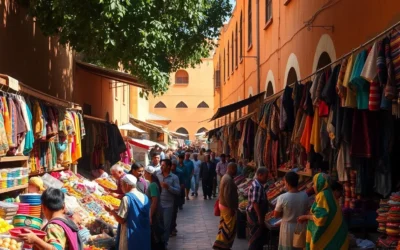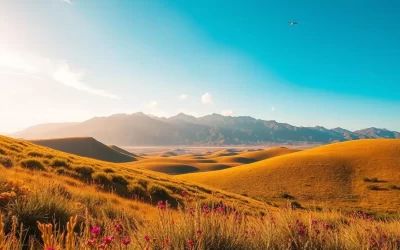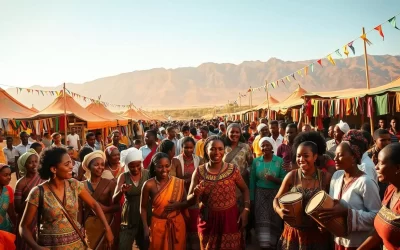✓ Accommodations✓ Flights✓ Rental Cars
Imagine stepping into a city that feels like a time capsule, where the blend of African, Middle Eastern, and Italian influences creates a unique cultural melting pot. Welcome to the capital of Eritrea, a destination that promises an unforgettable travel experience.
This city is a treasure trove of modernist architecture, earning it a UNESCO World Heritage status in 2017. As you wander through its streets, you’ll discover a fascinating blend of styles, frozen in time since the 1930s and 1940s. With its rich history, vibrant culture, and remarkable preservation, this place is a must-visit for any traveler looking for an authentic experience in a lesser-known country.
Discovering Asmara: Africa’s Modernist City
You are about to discover Asmara, a city that stands as a testament to early 20th-century modernist urban planning, with its roots deeply embedded in Italian colonial history. Asmara is a captivating blend of architectural wonders and cultural richness, featuring well-preserved Italian Art Deco buildings from the 1930s. The city’s unique architecture is a significant part of its history, reminding visitors of Eritrea’s colonial past.
A City Frozen in Time
Asmara stands as a remarkable example of modernist urban planning, with its streetscapes and buildings largely unchanged since the 1930s. Walking through Asmara feels like stepping back in time, with art deco buildings, wide boulevards, and vintage cafés creating an atmosphere unlike anywhere else in Africa. The city’s preservation is partly due to Eritrea’s isolation over the years, which inadvertently protected these architectural treasures from modernization and redevelopment.

UNESCO World Heritage Status
In 2017, UNESCO recognized Asmara’s unique architectural heritage by designating it as a World Heritage Site, acknowledging its outstanding universal value. The city earned its nickname “Little Rome of Africa” due to the extensive Italian architectural influence that transformed it during the colonial period from 1889 to 1941. This recognition highlights the importance of Asmara’s architecture and its significance in the country’s history.
Exploring Asmara’s Architectural Wonders
The city’s unique blend of futurist and Art Deco styles makes it a must-visit destination for architecture enthusiasts. As you explore Asmara, you’ll encounter a plethora of striking buildings that showcase its rich architectural heritage.
Fiat Tagliero Building
The Fiat Tagliero Building is an iconic architectural marvel, designed by Giuseppe Pettazzi in 1938. Its dramatic 30-meter concrete wings, resembling an airplane, make it a standout example of futurist architecture.
Cinema Impero
Cinema Impero, built in 1937, is one of the world’s best-preserved Art Deco theaters. Its original interior remains largely intact, and it still functions as a movie theater today, offering a glimpse into Asmara’s rich cultural heritage.
Opera House
The Opera House, built in 1918, is a testament to Asmara’s colonial-era entertainment. It features elegant curved staircases and a beautifully painted ceiling, making it a must-visit cultural venue.
These architectural wonders represent the bold and innovative designs that Italian architects experimented with in Asmara, creating a unique architectural landscape that defines the city’s character and its place in architectural history.
Religious Sites and Cultural Landmarks
Asmara’s religious sites are a testament to the city’s unique blend of cultures and faiths. The city’s religious diversity is reflected in its numerous churches, mosques, and synagogues, all coexisting peacefully within a small area.
Asmara Cathedral (Church of Our Lady of the Rosary)
The Church of Our Lady of the Rosary, often referred to as Asmara Cathedral, is one of the city’s most photographed landmarks. Built in 1923, this building features Lombard Romanesque architecture with a distinctive bell tower visible throughout the city. Visitors can admire its beauty and enter to experience its serene atmosphere.
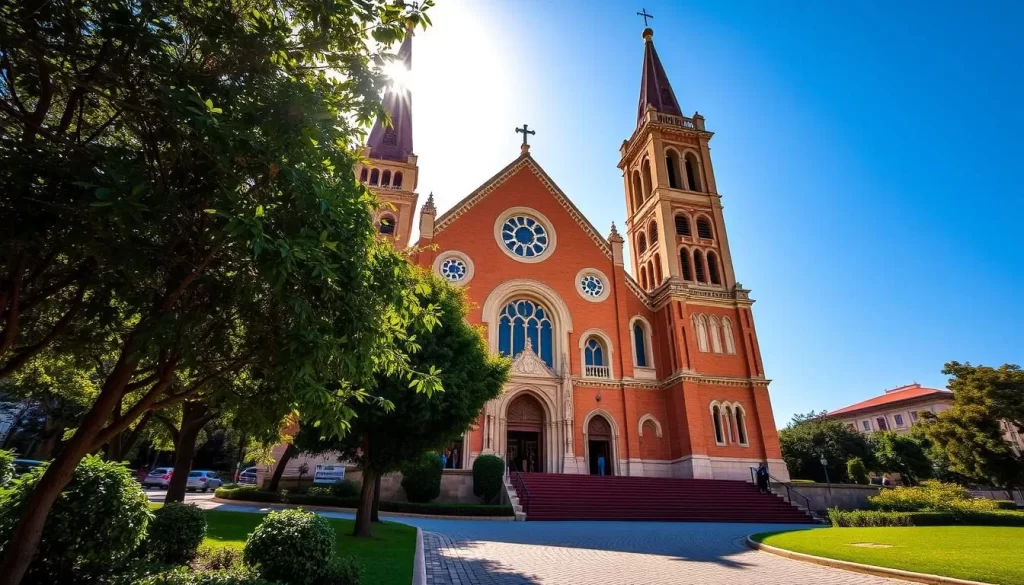
Khulafa al-Rashidun Mosque
Built in 1938, Khulafa al-Rashidun Mosque represents the Islamic architectural influence in Asmara. This building is characterized by its beautiful minaret and dome, serving the Muslim community in the city. While only Muslims can enter, visitors can appreciate its exterior beauty.
Enda Mariam Coptic Cathedral
Enda Mariam Coptic Cathedral is another prominent site in Asmara, showcasing the Ethiopian Orthodox tradition. Built in 1938, this building is known for its distinctive architectural style and colorful interior decorations, highlighting Eritrea’s connection to ancient Christian traditions. When you visit, you’ll see the things that make this cathedral a significant cultural landmark.
Strolling Through Asmara’s Historic Streets
Strolling through Asmara’s historic streets is like stepping into a time capsule, where modernist architecture and local culture blend seamlessly. As you explore these streets, you’ll experience the city’s unique charm and character.
Harnet Street
Harnet Street, or Liberation Avenue, is Asmara’s main thoroughfare and social hub. Lined with Italian-style cafés, shops, and impressive modernist buildings, it’s the perfect place to introduce yourself to the city‘s vibrant atmosphere. You’ll see locals gathering at outdoor cafés to enjoy espresso and watch the world go by, especially coming alive at night when residents take their evening passeggiata (stroll).
Sematat Avenue
Sematat Avenue connects to important government buildings, offering another perspective on the city‘s architectural landscape. While exploring, be cautious about photographing official buildings.
Asmara Market (Biassa)
The Asmara Market, locally known as “biassa,” is a must-visit for an authentic shopping experience. With sections dedicated to spices, textiles, handicrafts, and everyday goods, you can find unique souvenirs and interact with locals. Be sure to arrive during the daytime, as many stalls start closing around 5 pm. You can enjoy traditional coffee while browsing through the market, immersing yourself in the local culture.
| Location | Highlights | Best Time to Visit |
|---|---|---|
| Harnet Street | Cafés, modernist buildings, evening stroll | Day and night |
| Sematat Avenue | Government buildings, architectural landscape | Daytime |
| Asmara Market (Biassa) | Spices, textiles, handicrafts, traditional coffee | Daytime |
Unique Experiences in Asmara, Eritrea: Best Things to Do
Asmara, with its blend of colonial past and African heritage, provides visitors with a chance to engage in some truly one-of-a-kind activities. When you visit Eritrea, Asmara is a place that offers a mix of historical significance, cultural richness, and entertainment.
Vintage Bowling at the Bowling Alley
One of the unique things to do in Asmara is to experience vintage bowling at the historic bowling alley. Built in the 1950s, this bowling alley is one of the few from that era still surviving in the world. You can still bowl here and enjoy the nostalgic experience of having pins manually re-stacked. It’s a fun activity that gives you a glimpse into the past.
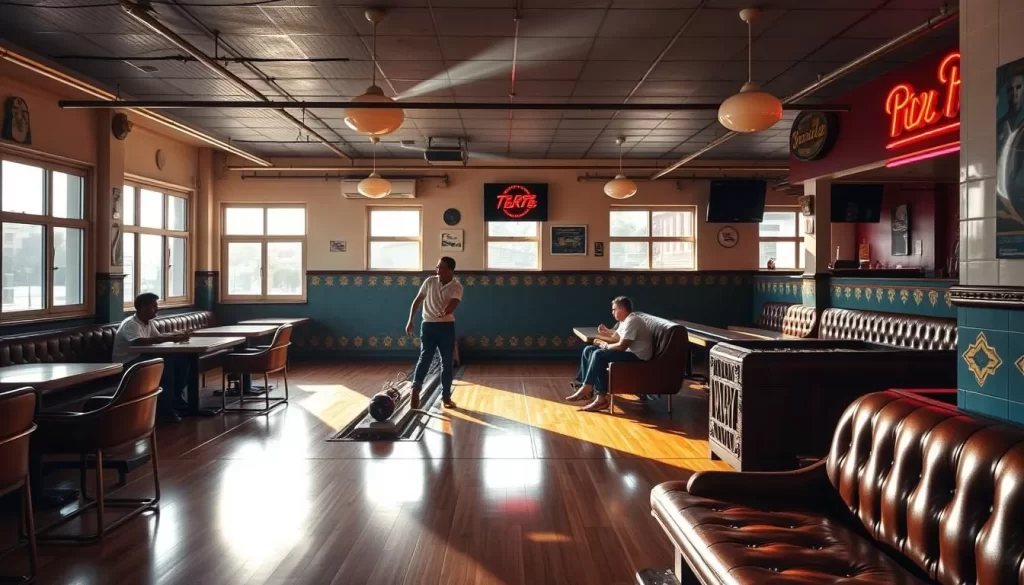
Steam Train Ride to Arberobo
Taking a steam train ride from Asmara to Arberobo is another unique experience. This journey on the historic Eritrean Railway offers breathtaking views of the countryside. To take this trip, you’ll need to secure a travel permit in advance, making it a special experience for those who plan ahead.
Tank Graveyard
The Tank Graveyard, a collection of Ethiopian tanks, trucks, and planes captured during the 30-year war for Eritrean independence, is a sobering reminder of the country’s history. Visiting this site is a poignant way to understand the struggle for Eritrea’s nationhood.
| Experience | Description |
|---|---|
| Vintage Bowling | Enjoy bowling like it’s the 1950s with manual pin setting at Asmara’s historic bowling alley. |
| Steam Train Ride | Travel on the historic Eritrean Railway from Asmara to Arberobo with breathtaking views. |
| Tank Graveyard Visit | Explore the collection of captured Ethiopian military equipment during Eritrea’s independence war. |
These unique experiences make your trip to Asmara truly memorable, offering a blend of history, culture, and entertainment that few other places can match.
Coffee Culture and Cuisine

In Asmara, the coffee culture and local cuisine offer a unique taste of the city’s rich heritage. You can experience the blend of traditional Eritrean flavors and Italian influences that define the city’s gastronomic identity.
Traditional Cafés and Italian Influence
Asmara’s coffee culture is characterized by its Italian-style espresso bars and art deco cafés, serving some of the finest coffee in Africa. The traditional coffee ceremony, known as “bun,” is a more authentic Eritrean experience where coffee beans are roasted, ground, and brewed in a jebena, a special clay pot, and served with popcorn or other snacks.
Must-Try Eritrean Dishes
Eritrean cuisine centers around injera, a sourdough flatbread made from teff flour that serves as both plate and utensil for various spicy stews (tsebhi) and vegetable dishes. The Italian colonial influence is evident in Asmara’s food scene, with excellent pasta, pizza, and gelato available alongside traditional Eritrean dishes, creating a unique fusion cuisine.
Best Places to Eat in Asmara
Popular places to eat in Asmara include traditional restaurants serving Eritrean food, Italian-style cafés with vintage interiors, and street food vendors offering quick, affordable local specialties. You can enjoy the city’s culinary delights in a variety of settings, from formal restaurants to casual street food stalls.
Day Trips from Asmara

Venturing out from Asmara, you can immerse yourself in the diverse traditions and stunning scenery that Eritrea has to offer. The city serves as a perfect base for exploring the surrounding region, with its rich history and cultural heritage.
Keren and the Monday Animal Market
Keren, located about 90km northwest of Asmara, offers a completely different atmosphere with its Middle Eastern feel and traditional way of life. The best day to visit Keren is during the Monday animal market, where Eritreans from across the Anseba region gather to buy and sell livestock.
Massawa and the Red Sea Coast
Massawa, a historic port city on the Red Sea coast, features Ottoman and Egyptian architectural influences alongside war-damaged buildings, telling the story of Eritrea’s complex history and struggle for independence. The city’s port and surrounding landscape offer a glimpse into the country’s past.
Qohaito Archaeological Site
The Qohaito Archaeological Site is situated on a high plateau with spectacular views of the Great Rift Valley. It contains ruins dating back 2,500 years to the pre-Axumite period, including ancient rock art and temple foundations, amidst a landscape still dotted with ruins.
These day trip options require travel permits but reward visitors with diverse experiences of Eritrea’s cultural heritage, from traditional market scenes to ancient ruins and coastal landscapes, making them essential additions to any comprehensive visit to the country. The journey to these destinations often takes you along scenic roads, providing a glimpse into rural Eritrean life.
Practical Travel Tips for Visiting Asmara
Before you embark on your journey to Asmara, it’s essential to understand the practical aspects of traveling to this unique city. Planning ahead will ensure a smoother and more enjoyable trip.
Visa Requirements and Travel Permits
To visit Eritrea, you’ll need to obtain a visa, either through an Eritrean embassy in your home country or via a travel agency that offers visa on arrival services, albeit at a higher cost. Additionally, for exploring locations outside Asmara, such as Keren, Massawa, and various archaeological sites, you’ll need to secure travel permits from the Ministry of Tourism in Asmara’s city center.
Getting Around Asmara
Asmara is a compact city, making it easily explorable on foot. Many attractions are within walking distance, and for longer journeys, affordable taxis are readily available. This ease of movement allows you to enjoy the city’s architectural wonders and cultural landmarks without hassle.
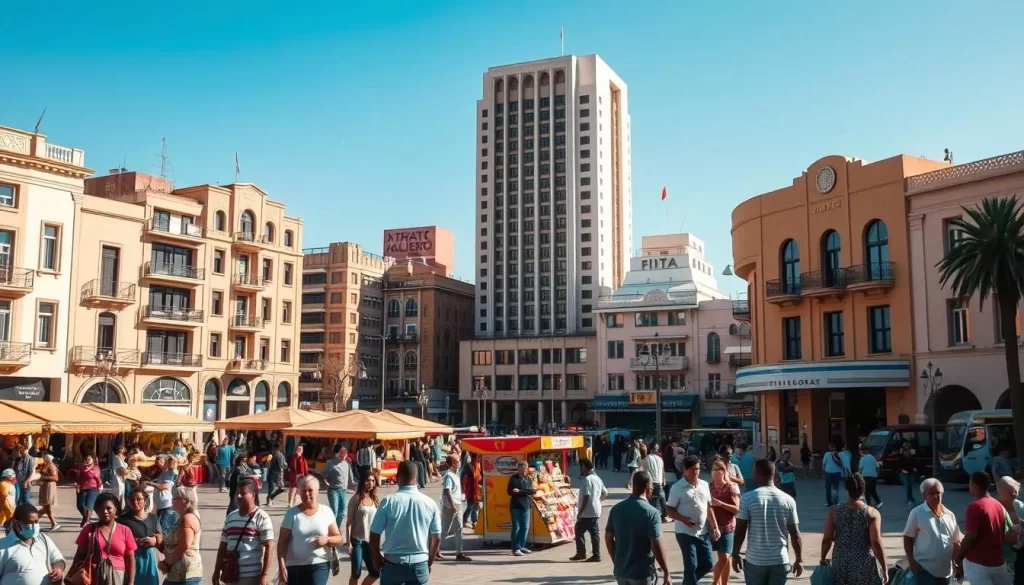
Accommodation Options
Asmara offers a range of accommodations to suit different budgets, from budget-friendly hotels like the Top Five Hotel to more upscale options such as the Crystal Palace and Asmara Palace. It’s advisable to book your accommodations in advance, especially during peak travel seasons, to ensure availability.
Conclusion
As you conclude your journey through Asmara, Eritrea, you’ll find that this African city has left an indelible mark on your travel experiences. With its rich history and vibrant culture, Asmara offers a unique blend of Italian colonial architecture and traditional Eritrean culture. The city’s Art Deco buildings and historic landmarks make it a fascinating destination for travelers. While obtaining the necessary travel permits may require some effort, the experience is well worth it. Asmara is a capital city that will captivate you with its charm, making your trip a memorable one.
The above is subject to change.
Check back often to TRAVEL.COM for the latest travel tips and deals.

